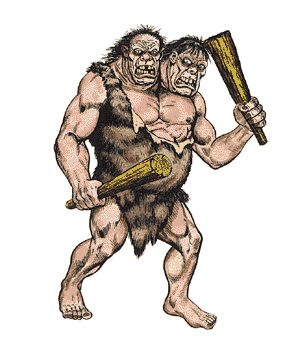

2140

| Climate/Terrain: | Subarctic to temperate/Hills and mountains |
|---|---|
| Frequency: | Very rare |
| Organization: | Solitary |
| Activity Cycle: | Night |
| Diet: | Carnivore |
| Intelligence: | Low (5-7) |
| Treasure: | O (C,Y) |
| Alignment: | Chaotic evil |
| No. Appearing: | 1 or 1-4 |
| Armor Class: | 3 |
| Movement: | 12 |
| Hit Dice: | 10 |
| THAC0: | 11 |
| No. of Attacks: | 2 |
| Damage/Attack: | 1-10/2-12 + weapon |
| Special Attacks: | Nil |
| Special Defenses: | Surprised only on a 1 |
| Magic Resistance: | Nil |
| Size: | H (13’ tall) |
| Morale: | Elite (14) |
| XP Value: | 3,000 |
Ettins, or two-headed giants, as they are often called, are vicious and unpredictable hunters that stalk by night and eat any meat they can catch.
An ettin at first appears to be a stone or hill giant with two heads. On closer inspection, however, the creature’s vast differences from the relatively civilized giant races become readily apparent. An ettin has pink to brownish skin, though it appears to be covered in a dark brown hide. This is because an ettin never bathes if it can help it, and is therefore usually encrusted with a thick layer of dirt and grime. Its skin is thick, giving the ettin its low Armor Class. An ettin’s hair is long, stringy, and unkempt; its teeth are large, yellowing, and often rotten. The ettin’s facial features strongly resemble those of an orc — large watery eyes, turned-up piggish snout, and large mouth.
An ettin’s right head is always the dominant one, and the right arm and leg will likely appear slightly more muscular and well-developed than the left. An ettin wears only rough, untreated skins, which are dirty and unwashed. Obviously, ettins smell very bad, due to their complete lack of grooming habits — good or bad.
Ettins do not have a true language of their own. Instead, they speak a mish-mash of orc, goblin, giant dialects, and the alignment tongue of chaotic evil creatures. Any adventurer who speaks orcish can understand 50% of what an ettin says.
Combat: Having two heads is definitely an advantage for the ettins, as one is always alert, watching for danger and potential food. This means that an ettin is surprised only on the roll of a 1 on 1d10. An ettin also has infravision up to 90 feet, which enables it to hunt and fight effectively in the dark. Though ettins have a low intelligence, they are cunning fighters. They prefer to ambush their victims rather than charge into a straight fight, but once the battle has started, ettins usually fight furiously until all enemies are dead, or the battle turns against them. Ettins do not retreat easily, only doing so if victory is impossible.
In combat, an ettin has two attacks. Because each of its two heads controls an arm, an ettin does not suffer an attack roll penalty for attacking with both arms. An ettin always attacks with two large clubs, often covered with spikes. Using these weapons, the ettin causes 2d8 points of damage with its left arm, and 3d6 points of damage with its right. If the ettin is disarmed or unable to use a weapon, it attacks empty-handed, inflicting 1d10 points of damage with its left fist and 2d6 points with its right.
Habitat/Society: Ettins like to establish their lairs in remote, rocky areas. They dwell in dark, underground caves that stink of decaying food and offal. Ettins are generally solitary, and mated pairs only stay together for a few months after a young ettin is born to them. Young ettins mature very quickly, and within eight to ten months after they are born, they are self-sufficient enough to go off on their own.
On rare occasions, however, a particularly strong ettin may gather a small group of 1d4 ettins together. This small band of ettins stays together only as long as the leader remains alive and undefeated in battle. Any major defeat shatters the leader’s hold over the band, and they each go their separate ways.
Ettins collect treasure only because it can buy them the services of goblins or orcs. These creatures sometimes serve ettins by building traps around their lairs, or helping to fight off a powerful opponent. Ettins have also been known to occasionally keep 1-2 cave bears in the area of their lairs.
The sloppy caves of ettins are a haven for parasites and vermin, and it isn’t unusual for the ettins themselves to be infected with various parasitic diseases. Adventurers rummaging through ettin lairs for valuables will find the task disgusting, if not dangerous.
Ecology: Because ettin society is so primitive, they produce little of any value to civilized creatures. Ettins tolerate the presence of other creatures, like orcs, in the area of their lair if they can be useful in some way. Otherwise, ettins tend to be violently isolationist, crushing trespassers without question.

◆ 802 ◆